J Sainsbury Bundle
Who Really Owns Sainsbury's?
Unraveling the ownership of J Sainsbury plc, a cornerstone of British retail, is key to understanding its strategic moves and market position. The company's journey, from a single dairy shop to a retail giant, is a testament to the impact of ownership dynamics. This exploration dives into the J Sainsbury SWOT Analysis, offering a comprehensive view of the forces shaping this iconic brand.
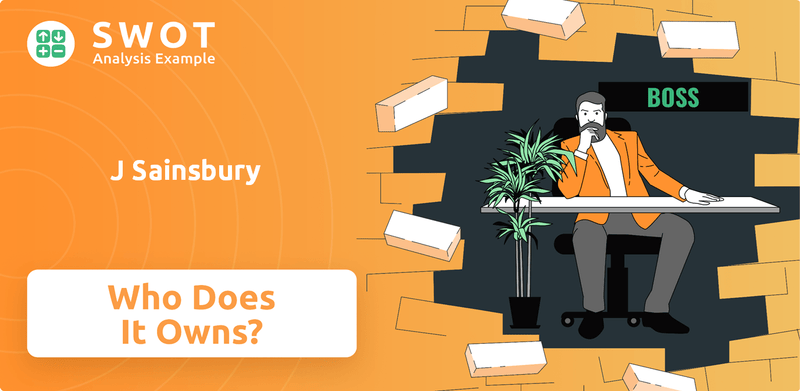
Understanding who owns Sainsbury's is vital for investors and anyone interested in the UK's retail landscape. This analysis will examine the Sainsbury's owner structure, from its historical roots to its current shareholders, offering insights into the company's governance and future prospects. Discover the evolution of Sainsbury's company structure and the key players influencing its direction, revealing the forces behind its enduring success. Learn about Sainsbury's shareholders and the impact of their investment on the company's performance.
Who Founded J Sainsbury?
The story of J Sainsbury's ownership begins in 1869 with John James Sainsbury and his wife, Mary Ann Sainsbury. They started a small dairy shop at 173 Drury Lane in London, focusing on high-quality dairy products. This marked the beginning of what would become a significant retail presence in the United Kingdom.
Initially, the business was a partnership, entirely owned and managed by the Sainsbury family. This structure allowed them to closely control the company's values and operations. Over time, the business expanded, growing to 135 shops by 1915, solidifying its position in the market.
The family's commitment to the business was evident, with family members holding key positions for many decades. This family-centric approach shaped the company's culture and its focus on quality and customer service.
John James Sainsbury and Mary Ann Sainsbury established the business in 1869. Their first shop was a dairy that sold butter, milk, and eggs.
Until 1973, the company was entirely owned by the Sainsbury family. This allowed for direct control over the company's vision.
The company was incorporated as J. Sainsbury Limited in 1922. This marked a significant step in its formal structure.
The initial public offering (IPO) occurred on July 12, 1973. It was the largest flotation on the London Stock Exchange at the time.
Even after the IPO, the Sainsbury family retained a substantial ownership stake. They kept around 85% of the shares.
As part of the IPO, a million shares were set aside for staff. This was designed to broaden the ownership base.
The decision to go public in 1973 was a strategic move to broaden the ownership base. The Sainsbury family, however, maintained a significant stake, ensuring their continued influence over the company's direction. This transition is a key part of understanding J Sainsbury's growth strategy and its evolution as a publicly traded company. The IPO allowed the company to access more capital for expansion, while the family retained considerable control. The company's history reflects a blend of family values and strategic business decisions, shaping its identity and market position.
Understanding the evolution of J Sainsbury ownership is crucial for investors and stakeholders interested in the company's history and future.
- Founded in 1869 as a partnership by John James Sainsbury and Mary Ann Sainsbury.
- The company remained family-owned until its IPO in 1973.
- The IPO was the largest flotation on the London Stock Exchange at the time.
- The Sainsbury family retained approximately 85% of the shares after the IPO.
J Sainsbury SWOT Analysis
- Complete SWOT Breakdown
- Fully Customizable
- Editable in Excel & Word
- Professional Formatting
- Investor-Ready Format
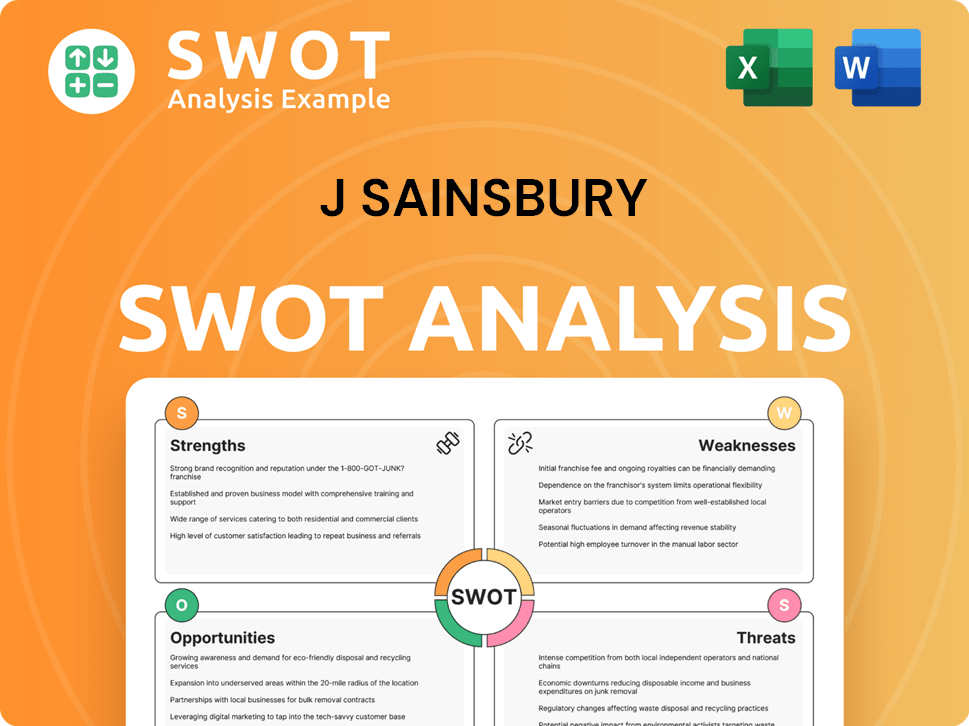
How Has J Sainsbury’s Ownership Changed Over Time?
The ownership of J Sainsbury plc, often referred to as Sainsbury's, has evolved significantly since its initial public offering (IPO) in 1973. Initially, the company was primarily family-owned, but it has since transitioned to a structure dominated by institutional and individual shareholders. This shift reflects broader trends in corporate governance, where large investment firms and other institutional investors play a crucial role in shaping a company's strategic direction. Understanding the current ownership structure is key for anyone interested in the company, from potential investors asking 'Who owns Sainsbury's' to those studying Sainsbury's company structure.
As of October 2023, institutional investors collectively held approximately 75.2% of J Sainsbury plc's total equity. This demonstrates their considerable influence on the company's strategic decisions and financial performance. The evolution of Sainsbury's shareholders has been marked by several key events, including acquisitions by significant investment groups and changes in the holdings of the founding Sainsbury family. This has led to a dynamic landscape of ownership, which continues to evolve.
| Event | Date | Impact |
|---|---|---|
| IPO | 1973 | Transition from family ownership to public ownership. |
| Delta Two Acquisition | May 2007 | Qatari investment company acquired a 14% stake, later increasing to 25%. |
| Current Ownership | May 19, 2025 | Institutional investors hold the majority of shares, with key players like Qatar Holdings LLC and VESA Equity Investment S.à.r.l. |
As of May 19, 2025, the major shareholders of Sainsbury's include Qatar Holdings LLC, holding 10.14% of voting rights, and VESA Equity Investment S.à.r.l. with 10.00%. BlackRock, Inc. holds 7.35%, Pzena Investment Management, Inc. holds 5.05%, and Bestway Group UK Limited holds 5.01%. These figures provide insight into 'Sainsbury's owner' and the company's current ownership breakdown by percentage. The Sainsbury family's influence has decreased over time, although they still maintain a presence in the company. For example, Lord Sainsbury of Turville held 4.99%, and Judith Portrait held 3.92% as of May 2011. The dynamic nature of Sainsbury's ownership is a key aspect of its corporate history and performance. For more insights, consider reading about the Marketing Strategy of J Sainsbury.
The ownership of Sainsbury's has shifted from family control to a diverse group of institutional investors.
- Institutional investors hold a significant majority of the shares.
- Key shareholders include Qatar Holdings LLC and VESA Equity Investment S.à.r.l.
- The Sainsbury family still maintains a stake, though smaller than in the past.
- The ownership structure influences the company's strategic decisions.
J Sainsbury PESTLE Analysis
- Covers All 6 PESTLE Categories
- No Research Needed – Save Hours of Work
- Built by Experts, Trusted by Consultants
- Instant Download, Ready to Use
- 100% Editable, Fully Customizable
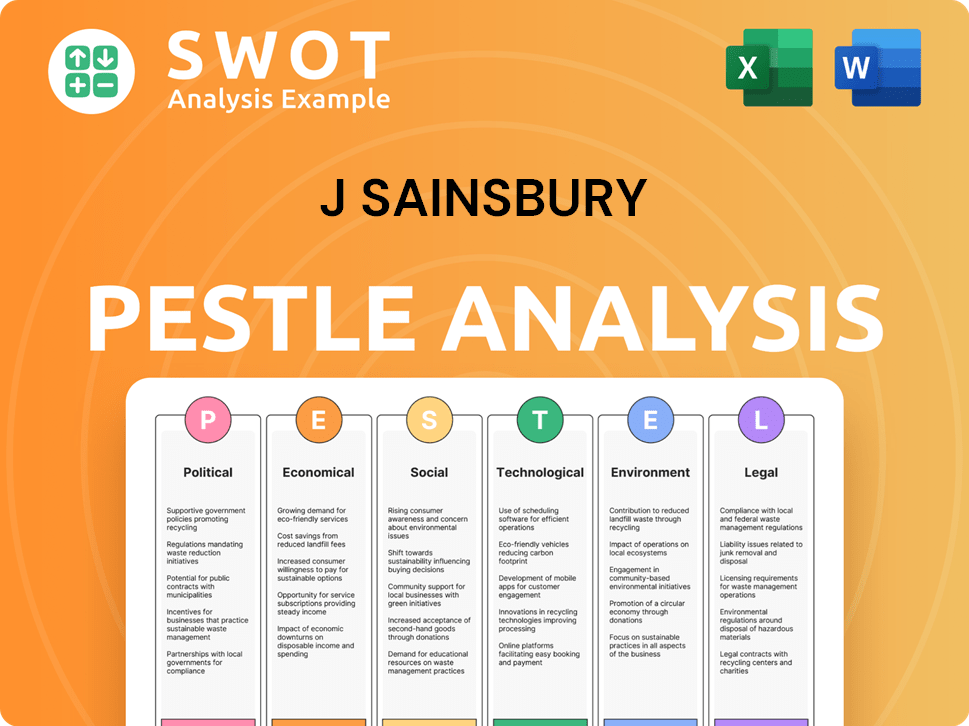
Who Sits on J Sainsbury’s Board?
The Board of Directors of J Sainsbury plc is responsible for overseeing the company's strategic direction and representing shareholder interests. As of April 2025, the Chairman is Martin Scicluna, and Simon Roberts serves as the Chief Executive Officer. The company's governance structure is designed to ensure accountability and effective decision-making.
Recent changes to the Board were announced in April 2025. Katie Bickerstaffe and Steve Hare are set to join as Non-Executive Directors following the Annual General Meeting (AGM) on July 3, 2025. Katie Bickerstaffe will be on the Corporate Responsibility and Sustainability Committee and the Nomination and Governance Committee, while Steve Hare will join the Audit and Nomination and Governance Committees. Brian Cassin will not seek re-election at the July 3, 2025 AGM. Adrian Hennah will succeed Brian Cassin as Senior Independent Director from July 3, 2025.
| Director | Title | Appointment Date |
|---|---|---|
| Martin Scicluna | Chairman | September 2018 |
| Simon Roberts | Chief Executive Officer | June 2020 |
| Katie Bickerstaffe | Non-Executive Director | July 2025 |
The voting structure of J Sainsbury plc typically follows a one-share-one-vote system, common for companies listed on the London Stock Exchange. Major institutional shareholders, such as Qatar Holdings LLC and VESA Equity Investment S.à.r.l., hold significant stakes, which gives them considerable voting power. Understanding the J Sainsbury ownership structure is key for investors. The composition of the board, with independent directors and representatives of major shareholders, aims to balance various interests. For more insights into the company's strategic direction, consider exploring the Growth Strategy of J Sainsbury.
Understanding Sainsbury's owner and its company structure is crucial for investors. The board includes a mix of executive and non-executive directors. The voting power is largely determined by share ownership, with major shareholders influencing key decisions.
- Martin Scicluna is the Chairman.
- Simon Roberts is the CEO.
- Major shareholders have significant voting power.
- New directors are joining the board in July 2025.
J Sainsbury Business Model Canvas
- Complete 9-Block Business Model Canvas
- Effortlessly Communicate Your Business Strategy
- Investor-Ready BMC Format
- 100% Editable and Customizable
- Clear and Structured Layout
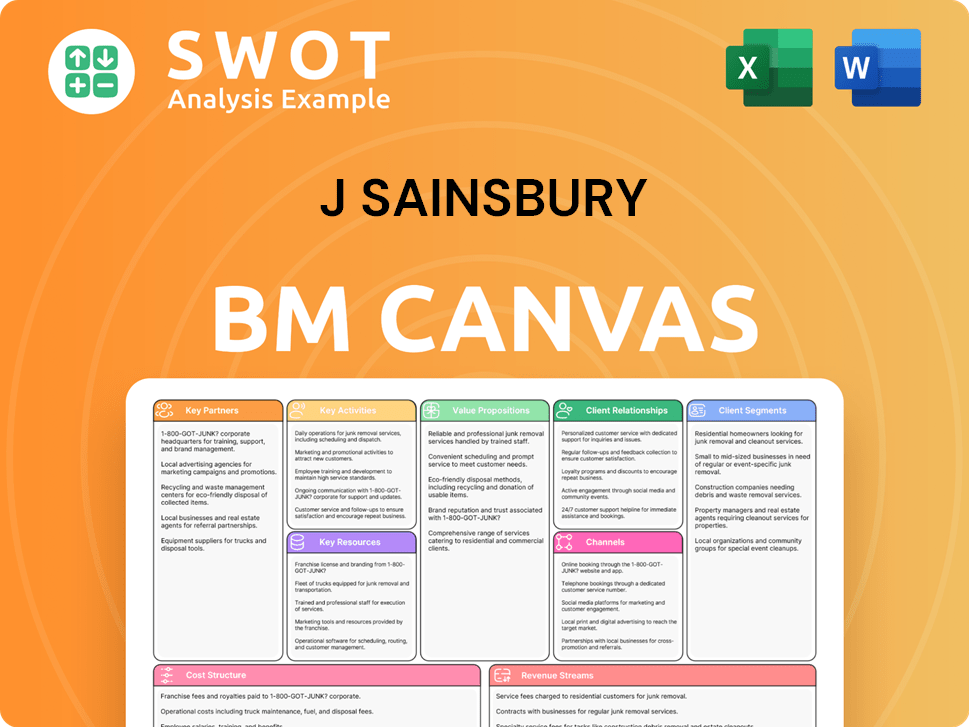
What Recent Changes Have Shaped J Sainsbury’s Ownership Landscape?
Over the past few years, the focus of J Sainsbury plc, and its J Sainsbury ownership, has been on streamlining its operations. A significant move includes the phased withdrawal from core banking services. This involves the sale of several financial portfolios, including personal loans, credit cards, and retail deposits, with the transactions expected to conclude by May 2025. Further, the sale of the ATM business and the Argos Financial Services (AFS) cards portfolio were completed in 2024 and early 2025, respectively.
These strategic shifts are expected to free up capital. Sainsbury's Bank is slated to return at least £250 million of excess capital to Sainsbury's. The company plans to return this capital to shareholders, potentially through a special dividend. Additionally, the company has actively engaged in share buyback programs to reduce its share capital. In April 2025, a share buyback program of up to £200 million was initiated, following a previous year's £200 million buyback. Furthermore, the company anticipates at least another £200 million in buybacks for the 2025-26 period.
| Transaction | Date Announced | Expected Completion |
|---|---|---|
| Sale of personal loan, credit card, and retail deposit portfolios | June 2024 | May 2025 |
| Sale of ATM business | September 2024 | Completed |
| Sale of Argos Financial Services (AFS) cards portfolio | October 2024 | February 2025 (beneficial title acquired) |
| Share Buyback Program | April 2025 | September 12, 2025 |
Leadership changes have also played a role in shaping the company's direction. In January 2024, changes to the operating board were announced to align with the next phase of its strategy. Rhian Bartlett now leads the commercial proposition across grocery, general merchandise, and clothing. Graham Biggart has taken on the role of Managing Director for Argos. These changes are aimed at enhancing decision-making and improving performance across both Sainsbury's and Argos. The 'Next Level Sainsbury's' strategy, unveiled in February 2024, emphasizes being the 'first choice for food,' enhancing loyalty, and optimizing Argos operations, aiming for £1 billion in cost savings by March 2027. For more context, you can explore the Competitors Landscape of J Sainsbury.
Sainsbury's initiated a share buyback program for up to £200 million in April 2025, scheduled to conclude by September 12, 2025, which aims to decrease the company's share capital.
The 'Next Level Sainsbury's' strategy is targeting £1 billion in cost savings by March 2027, as part of its strategic focus on enhancing operational efficiency.
Sainsbury's plans to return at least £250 million of excess capital from Sainsbury's Bank to shareholders, potentially through a special dividend.
The company's focus on streamlining operations and financial restructuring reflects shifts in Sainsbury's owner and Sainsbury's shareholders.
J Sainsbury Porter's Five Forces Analysis
- Covers All 5 Competitive Forces in Detail
- Structured for Consultants, Students, and Founders
- 100% Editable in Microsoft Word & Excel
- Instant Digital Download – Use Immediately
- Compatible with Mac & PC – Fully Unlocked
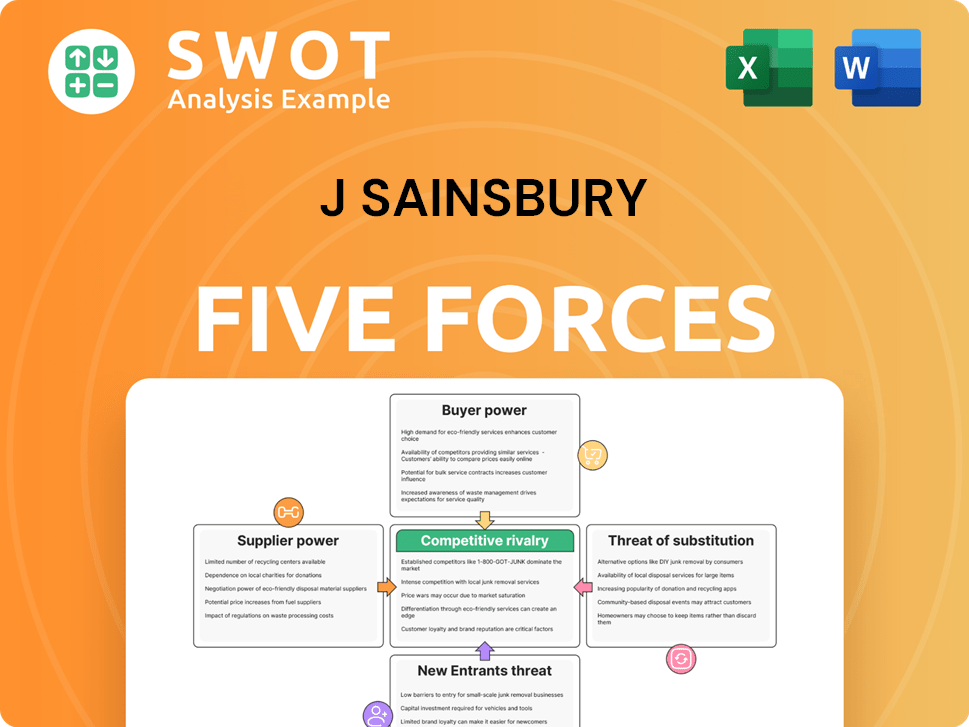
Related Blogs
- What are Mission Vision & Core Values of J Sainsbury Company?
- What is Competitive Landscape of J Sainsbury Company?
- What is Growth Strategy and Future Prospects of J Sainsbury Company?
- How Does J Sainsbury Company Work?
- What is Sales and Marketing Strategy of J Sainsbury Company?
- What is Brief History of J Sainsbury Company?
- What is Customer Demographics and Target Market of J Sainsbury Company?
Disclaimer
All information, articles, and product details provided on this website are for general informational and educational purposes only. We do not claim any ownership over, nor do we intend to infringe upon, any trademarks, copyrights, logos, brand names, or other intellectual property mentioned or depicted on this site. Such intellectual property remains the property of its respective owners, and any references here are made solely for identification or informational purposes, without implying any affiliation, endorsement, or partnership.
We make no representations or warranties, express or implied, regarding the accuracy, completeness, or suitability of any content or products presented. Nothing on this website should be construed as legal, tax, investment, financial, medical, or other professional advice. In addition, no part of this site—including articles or product references—constitutes a solicitation, recommendation, endorsement, advertisement, or offer to buy or sell any securities, franchises, or other financial instruments, particularly in jurisdictions where such activity would be unlawful.
All content is of a general nature and may not address the specific circumstances of any individual or entity. It is not a substitute for professional advice or services. Any actions you take based on the information provided here are strictly at your own risk. You accept full responsibility for any decisions or outcomes arising from your use of this website and agree to release us from any liability in connection with your use of, or reliance upon, the content or products found herein.